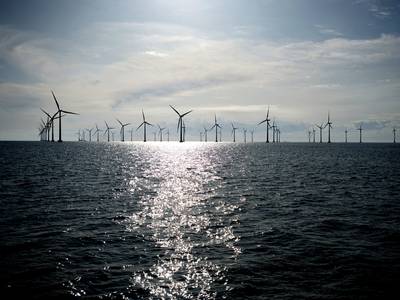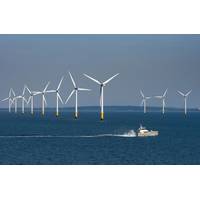Offshore Wind Industry Races to Cut Costs as Subsidies Drop
As European governments start to curb offshore renewable power subsidies, utilities, wind turbine makers and installers are racing to cut costs to help the industry survive.
Britain, Germany and the Netherlands, wary of committing billions of euros when budgets are tight, have announced subsidy cuts in the past 18 months - a blow to the European offshore wind industry which employs nearly 60,000 people.
This has led the European Wind Energy Association (EWEA) to slash its forecasts for installed offshore capacity in Europe to about 25 gigawatts (GW) by 2020, from a 2009 forecast for 40 GW, still more than triple current capacity of about 7 GW.
However, utilities remain keen to invest in offshore wind - which the EWEA says is the fastest-growing power technology in Europe.
Unlike onshore farms, marine parks face less opposition from civil groups who say they blight the landscape, so there is no limit on turbine size. Steady seawinds also allow turbines to turn about 42 percent of the time, about double the "load factor" onshore.
However, offshore parks are far more expensive and as the industry seeks to weather the subsidy cuts until investments pay off, companies are desperately seeking to reduce construction costs by building bigger, more efficient turbines and finding cheaper ways to construct foundations.
Offshore wind costs about 125 euros per megawatt hour (MWh), versus 80 euros for onshore wind, according to EU data. However, that is expected to fall below 100 euros by the end of decade.
Even so, offshore wind will only cover about 3 percent of Europe's power consumption by 2020, from under 1 percent now.
A project off Germany - 35 km north of Heligoland, in North Sea waters 20-25 metres deep - underlines the industry's determination to forge ahead with this technology.
German utility E.ON is relying on dozens of companies, including Siemens (SIEMENS.NS), to build Amrumbank West, a 288 megawatt (MW) offshore wind farm whose 80 turbines will supply power to more than 300,000 households.
But only after robots have scoured the seabed for unexploded bombs and ammunition dropped by allied forces during World War Two, so specialised ships can hammer each turbine's steel pipe foundations 30-40 metres into the ground.
Everything about offshore wind is gigantic, including the costs: about 1 billion euros ($1.25 billion) for Amrumbank. Each 500-tonne monopile foundation is 60 metres high and 6 metres wide and is bolted to a 90-metre tower. Then, floating cranes hoist up the 125-tonne turbine housing and attach three 18-tonne blades, on days when the sea is calm and the wind not too strong.
"What's good for operation is bad for construction," said E.ON board member Mike Winkel, pointing at the cloudy sky and buffeted by the fierce, cold winds typical of the area.
Bigger Blades
Size is offshore's biggest advantage, as the amount of wind captured by a turbine increases exponentially with blade length.
Manufacturers are cutting costs by simplifying turbines, by making them drive generators directly rather than through a gearbox, and by putting more of the generating equipment in the tower instead of the turbine housing itself.
Amrumbank West uses 3.6 MW Siemens turbines with a rotor diameter of 120 metres. Siemens now sells 6 MW models with a diameter of 154 metres, while Denmark's Vestas and France's Areva are developing 8 MW models.
The world's first wind farm Vindeby in Denmark, which went online in 1991 and still operates, has 0.45 MW turbines with a rotor diameter of 35 metres. Its 11 turbines have a capacity of just 5 MW, as much as one big turbine today.
The biggest challenge for offshore is installation. Even without unexploded bombs on the sea floor, building foundations is a slow, dangerous and expensive process, tailor-made for the soil, wind and wave conditions of each site.
At Amrumbank, E.ON cuts costs by using bolts instead of concrete to connect the monopiles with platforms on which turbines will be placed.
Automation is the way to cut foundation costs, said Frederic Lanoe, French country manager for Portugal's EDP Renewables , part of a consortium building a 1,000 MW offshore wind farm in France.
"We need to standardise the process of manufacturing offshore foundations, like we have done with turbines," he said.
Like the oil industry before it, offshore wind started on land and then moved into ever-deeper water.
Turbines on foundations are limited to maximum depths of about 40 metres - but the industry has already built prototypes of floating turbines, opening the door for countries with deep-water coastlines.
($1 = 0.8023 euro)
(By Christoph Steitz and Geert De Clercq; Editing by Pravin Char)













